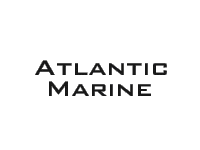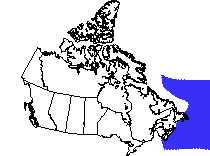|
Location
| Climate | Geography | Flora
and fauna | Humans
Location
Farther out to sea than the Northwest Atlantic Marine ecozone, this
ecozone only touches land at the southern coast of New Brunswick and
Nova Scotia and the eastern coast of Nova Scotia and Newfoundland.
Climate
Winds coming from the land to the west and the warm Gulf Stream from
the south both make the Atlantic Marine ecozone more temperate than
it would otherwise be. Dense fog banks form where the cold northern
Labrador Current meets the Gulf Stream off of Newfoundland. Late winter
and early spring brings icebergs to the Grand Banks and the Newfoundland
coast, and the northern part of the ecozone is known as "Iceberg Alley"
by sailors. The Bay of Fundy features the largest tides in the world,
the difference between high and low tide topping 15 metres
Geography
Most of the ecozone is thousands of metres deep, although the famous
Grand Banks off of Newfoundland average only 150 metres over large areas.
Flora
and Fauna
Plants
Tiny aquatic organisms
called phytoplankton live in the ocean, providing the basis for the
food web. Giant kelp and seaweed are common, especially in intertidal
zones. The frequent salt marshes that are found at the water’s edge
contain such species as saltmarsh cord grass, marsh meadow grass, spike
grass, wild barley, sea lavender and sea plantain, all of which are
resistant to the salty water.
Animals
Mammals
Marine mammals, such as harbour
seal, grey
seal, harbour
porpoise, atlantic
harbour porpoise, longsnout
dolphin, orca,
atlantic beaked
whale, northern
bottlenose whale, blue
whale, fin
whale, pilot
whale, beluga,
minke whale,
blue whale,
atlantic right
whale, sperm
whale, and humpback
whale are found living in or migrating through the area.
Birds
Many of the bird species live on the water all year, only coming onto
land to breed, such as the northern
fulmar, greater shearwater, dovekie, common
murre, and thickbilled
murre. Leach’s
storm petrel, arctic
tern, eider.
Various kittiwakes, puffins, cormorants and gulls are common birds found
here.
Fish
Common fish species in the area include atlantic tomcod, mummichog,
redfish, herring, silver hake, Greenland halibut (turbot), and the dangerously
overfished northern cod. Several fish, such as the sea lamprey, atlantic
sturgeon, alewife, atlantic salmon and American eel live most of their
lives in the ocean but enter freshwater to spawn.
Crustaceans
The crustaceans found here include stone
crab, Neolithodes
grimaldii, American
lobster, rock
crab, Lucifer
faxoni, Sclerocrangon
boreas, acadian
hermit-crab, striped
pink shrimp, Lebbeus
groenlandicus, and Axius
serratus.
Other Invertebrates
The large shallow areas of the ecozone provide habitat for a surprising
number of barnacles, sea stars, sponges, clams, jellyfish, and other
invertebrates.
Humans
The Grand Banks lie here off the Newfoundland coast. When European explorers
first came here four centuries ago they claimed that the fish were so
dense that they would slow ships. Since then, fishing has been so intense
that fish stocks have plummeted and Canada actually banned cod fishing
in 1992 to prevent the commercial extinction of cod. Today fishing has
turned to other species and the offshore oil and gas fields hold hope
for the region's battered economy.
 

|
|







